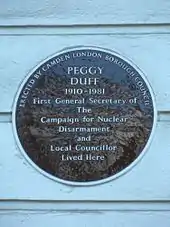Peggy Duff
Peggy Duff (8 February 1910 – 16 April 1981) was a British political activist who started off her career with a protest against the treatment of German prisoners of war in Britain after the Second World War. She was principally known for her contribution to the peace movement as the organiser of the Campaign for Nuclear Disarmament. She was described by Noam Chomsky as "one of the people who really changed modern history".[1]
Peggy Duff | |
|---|---|
| Born | Margaret Doreen Eames 8 February 1910 |
| Died | 16 April 1981 (aged 71) London, United Kingdom |
| Nationality | British |
| Alma mater | Bedford College, University of London |
| Occupation | Journalist, activist |
Background
Duff was born as Margaret Doreen Eames. Her father, Frank Eames, was a stockbroker's clerk in suburban Middlesex. She attended Hastings Secondary School for Girls. The headmistress noted that she was "very public-spirited". She then went to Bedford College, University of London, where she read English.
After university she worked as a journalist and in 1933 married Bill Duff, a fellow journalist. He was killed during the Second World War while covering an American air raid on the Burma railway for an armed forces' newspaper. The couple had two daughters and a son (photo-journalist Euan Duff). Duff began her involvement in peace campaigning in the late 1930s.
Political activism
During the war Duff joined Common Wealth, an idealistic socialist party to the left of Labour set up by Sir Richard Acland. After the 1945 election in which Common Wealth ceded its vote to the Labour Party, Duff was employed by Victor Gollancz's organization Save Europe Now, which sent food and clothing to occupied Germany and Austria from rationed Britain, and campaigned for the repatriation of prisoners of war. From 1949 to 1955 she was business manager of Tribune, then identified with the supporters of Aneurin Bevan. .
Briefly working with Victor Gollancz again, Duff became the secretary of the National Campaign for the Abolition of Capital Punishment, set up in August 1955, in part, as a response to a number of controversial executions (including that of Ruth Ellis). In 1956 she was elected as a Labour member of St Pancras Borough Council, where she became known as Chief Whip for the Labour group. She also supported the rights of tenants of council housing, but in doing so gave the green light to controversial architectural redevelopments and slum clearance programmes that are often considered to have blighted the ward she served.
CND
At the Labour Party conference in 1957, Aneurin Bevan, then Shadow Foreign Secretary, astonished his supporters by denouncing demands for unilateral nuclear disarmament. In November that year, Duff responded by joining with others to establish the Campaign for Nuclear Disarmament (CND), which aimed to persuade Britain to "renounce unconditionally the use or production of nuclear weapons and refuse to allow their use by others in her defence". Duff became the Organising Secretary for the campaign, and her energy and resilience became well known to its supporters. Canon John Collins, Chair of CND, noted that she never gave the impression of efficiency 'and seemed thoroughly slapdash', but that her work had impressive results. She organised the second and subsequent Aldermaston Marches, 1959–63.[2]
Later life
In 1965 she commenced work for the International Confederation for Disarmament and Peace, resigning as General Secretary of CND in 1967. She resigned from the Labour Party on 10 May 1967 over Harold Wilson's diplomatic support for the United States in the Vietnam war and refusal to condemn the Greek dictatorship of "the Colonels". In later life she wrote her memoirs, Left, Left, Left (Allison & Busby, 1971), and edited and wrote part of War or Peace in the Middle East? (1978), in which she argued for "no more blank cheques for Israel". She died of breast cancer in University College Hospital, aged 71. . She was buried at Hampstead Cemetery.[3]
Evaluation
Noam Chomsky called Duff "one of those heroes who is completely unknown, because she did too much," and stated that "she should have won the Nobel Peace Prize about twenty times." He described her as a "leading figure," in both the CND and the anti-Vietnam War movement.[4]
Legacy

Camden London Borough Council erected a claret plaque at 11 Albert Street, London NW1, in tribute to her, reading: "Peggy Duff, 1910 – 1981, first General Secretary of the Campaign for Nuclear Disarmament and local councillor, lived here."[5]
See also
References
- Robert Barsky, "The Example of Peggy Duff" Archived 2013-01-16 at the Wayback Machine, in Noam Chomsky: A Life of Dissent, MIT Press, 1998.
- Douglas Holdstock and Frank Barnaby (eds), The British Nuclear Weapons Programme, 1952–2002, Frank Cass & Co., 2003, p. 59.
- "Peggy Duff", Find A Grave.
- Chomsky, Noam, The Chomsky Sessions: Noam Chomsky On The World. DOCURAMA DVD: 18 November 2008. Minutes 4—7.
- "Plaque: Peggy Duff", London Remembers.
| Preceded by Newly founded |
General Secretary of CND 1958–67 |
Succeeded by Dick Nettleton |
